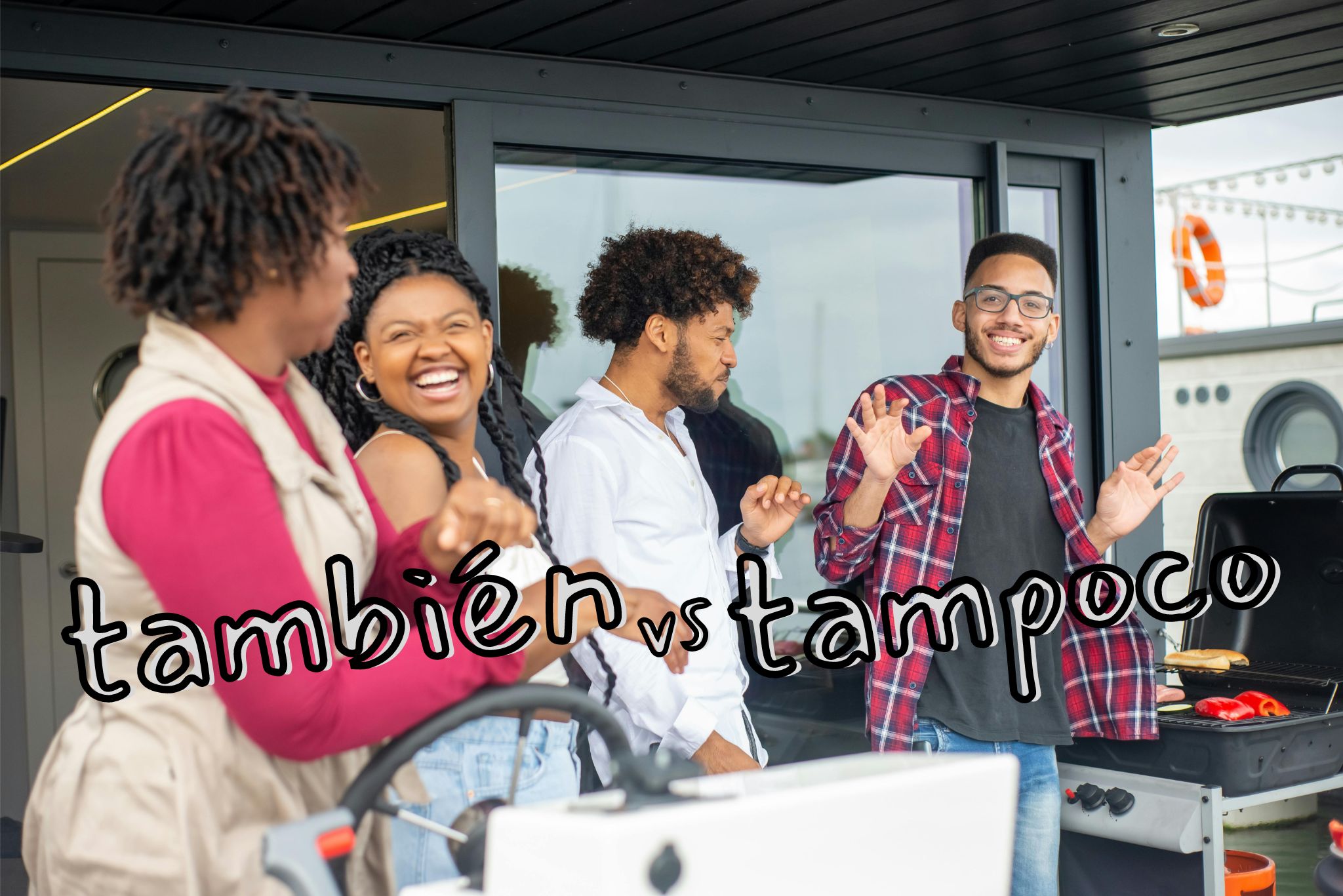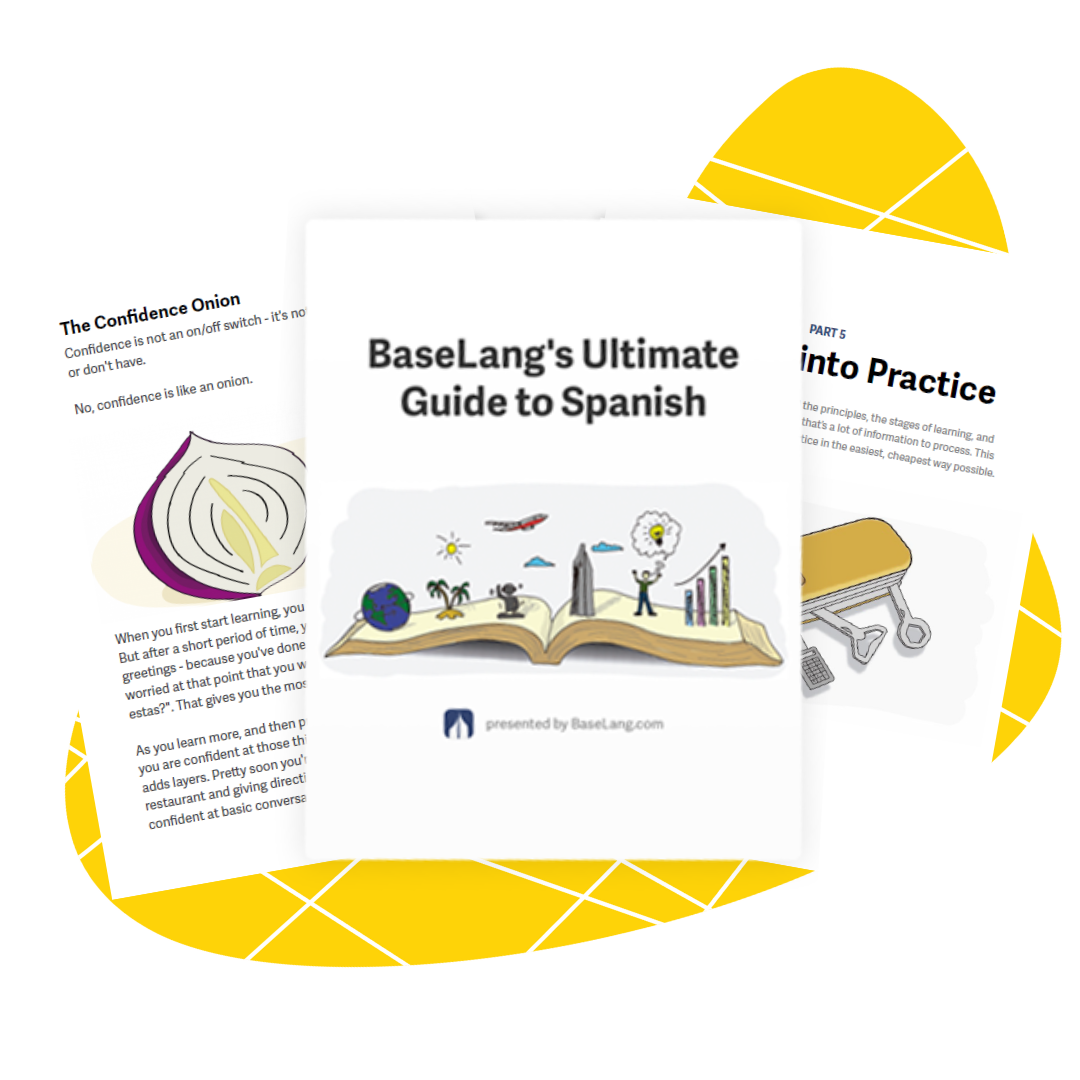También and Tampoco: Agreement words in Spanish

Get our free email course, Shortcut to Conversational.
Have conversations faster, understand people when they speak fast, and other tested tips to learn faster.
More infoIn today’s post, we’ll deal with two words that are as important as knowing how to say yes and no in Spanish: también and tampoco.
No matter your level of Spanish, mastering the use of también and tampoco will make a big difference. We use both of these terms when we want to agree with something that was previously stated.
For this reason, many Spanish learners get confused between también vs tampoco. Indeed, both are adverbs. However, they’re each used in different scenarios!
Today we’ll give you a detailed guide on the meaning of each term, we’ll demonstrate how también and tampoco are each used, and as usual, we’ll provide you with tons of examples so you can really grasp the nuances in their use.
Now let’s get started with our full guide to tampoco vs también!
También in Spanish
What does También mean in Spanish?
También in English can mean as well, too, or also. We use también to add information, to note similarity, or express agreement with what was previously said.
- I read novels, but I read short stories as well. – Leo novelas pero también leo cuentos.
- I didn’t know that you go to the mountains on your vacations. We go to the mountains too. – No sabía que ustedes van a la montaña de vacaciones. Nosotras también vamos a las montañas.
- Marta eats healthily. Me too. – Marta come saludable. Yo también.
How to use También in Spanish
También in English can be translated as too, also, or as well. The important detail here is that the también meaning is always positive or affirmative. In other words, when someone makes an affirmative statement in Spanish, and you want to agree with it and highlight the similarity of your situation to the speaker’s, you use también.
- I study Japanese. / What a coincidence! Me too. – Yo estudio japonés. / ¡Qué coincidencia! Yo también.
- I also want to study Japanese. – Yo también quiero estudiar japonés.
We can also use también to add more information to what was just stated.
- The cake was made with fresh lemons, and it also had whipped cream. – El pastel estaba hecho con limones frescos, y también tenía crema batida.
- The hotel has an excellent room service, and a beautiful spa as well. – El hotel tiene un excelente servicio a la habitación y un spa hermoso también.
When reacting to an affirmative statement, we can use también along with a full repetition of the statement to express agreement.
- My kids want to go to the pool. / Mine want to go to the pool too. – Mis hijos quieren ir a la piscina. / Los míos también quieren ir a la piscina.
We can also just shorten our response and use también to confirm the same thing.
- Your neighbor has a Pekinese dog? I do too! – ¿Tu vecino tiene un perro pequinés? ¡Yo también!
So where do we place también in a sentence? It can be positioned either before or after the verb.
- I’m going too. – Yo también voy. – Yo voy también.
Last but not least, in case you’ve seen también written without an accent and you’re wondering, does también take an accent? The answer is yes: también should always bear an accent. Remember that Spanish accent marks are integral parts of words, so the unaccented tambien in Spanish does not exist.
Tampoco in Spanish
What does Tampoco mean in Spanish?
Tampoco in English can be translated as neither, not either, or nor. Tampoco is used to express agreement with a negative statement.
- I don’t take cooking classes. / Me neither. – Yo no tomo clases de cocina. / Yo tampoco.
- I don’t want them in my house either, they are very dirty. – Yo tampoco los quiero en mi casa, son muy sucios.
- I haven’t passed the math exam, nor the language exam . – No he aprobado el examen de matemática, ni tampoco el de lengua.
How to use Tampoco in Spanish
Tampoco is used to express agreement with a negative statement uttered by someone else. Like we saw with también, we have the option of repeating the negative phrase or omitting it.
- The kids didn’t go to school today. / We didn’t go to school either. – Los niños no fueron al colegio hoy. / Nosotros tampoco fuimos al colegio.
- No dormí lo suficiente. / Yo tampoco dormí lo suficiente. – I didn’t get enough sleep. / I didn’t get enough sleep either.
- I don’t want to travel by train. / Neither do I. – No quiero viajar en tren. / Yo tampoco.
- They don’t want to do homework. / Neither do we. – Ellos no quieren hacer la tarea. / Nosotros tampoco.
In our first examples, tampoco is placed before the verb, while in the next examples the verb is omitted but implied. This is the most common sentence structure with tampoco, where we place it before the verb.
Another sentence structure is possible with tampoco, however, but it requires the use of the double negative. We place the Spanish negation word no before the verb, with tampoco coming after the verb.
- Martina is not going to the cinema today. I’m not going either. – Martina no va al cine hoy. Yo no voy tampoco.
- Carlos doesn’t agree either. – Carlos no está de acuerdo tampoco.
Finally, in an informal context, we sometimes use tampoco to diminish the significance of a previous comment.
- I’m really mad. / Come on, it’s not such a big deal. – Estoy muy enojada. / Bueno, tampoco es para tanto.
How to use También and Tampoco with verbs like Gustar
A number of Spanish verbs that refer to sentiments have a different structure, whereby we essentially switch the subject and the indirect object. The most common of these is gustar, meaning to like, so we conjugate I like as a mí me gusta. Other common verbs like gustar in Spanish include encantar, interesar, importar, or molestar.
When we use también and tampoco to express agreement with any statement that’s built on one of these verbs, we need to use this same structure with these prepositional pronouns (a mí, a ti, a él, etc).
- I like mountains. / Me too. – Me gustan las montañas. / A mí también.
- I’m not interested in economy. / Neither is Julieta. – No me interesa la economía. / A Julieta tampoco le interesa.
Bonus: Disagreeing in Spanish
So far we’ve been talking about agreeing with affirmative and negative statements. But what about disagreeing? In this case, we use neither también nor tampoco.
To express disagreement in Spanish, the formula is even easier than using también or tampoco. We just need to add Yes or No in Spanish! Let’s see how to agree with both affirmative and negative statements.
Disagreeing with affirmative sentences
When disagreeing with affirmative sentences, we simply say no after the person who disagrees. Let’s see this in some examples.
- My kids want to go the swimming pool. / We don’t. – Mis niños quieren ir a la piscina. / Nosotros no.
- I read novels. / Not Zoe. She reads short stories. – Yo leo novelas. / Zoe no. Ella lee cuentos.
- I love horror movies. / I don’t. – Me encantan las películas de terror. / A mí no.
In our last example we showed that we still need to use a mí, a ti, and so on when using verbs like gustar.
Disagreeing with negative sentences
If someone makes a negative statement and you want to disagree with it, you need to react with an affirmative phrase. This works the same way as we saw above with no, but to make it positive we use sí instead.
Let’s see this using the same examples that we saw with the affirmative statements.
- My kids don’t want to go to the swimming pool. / We do. – Mis niños no quieren ir a la piscina. / Nosotros sí.
- I don’t read novels. / Zoe does. She reads long novels. – No leo novelas. / Zoe sí. Lee novelas largas.
- I don’t love horror movies. / I do. – No me encantan las películas de terror. / A mí sí.
Conclusion: También vs Tampoco
Today we focused on everything you need to know about también and tampoco in Spanish. We learned that both are used to agree with a previous statement: también is used to agree with positive statements, whereas tampoco is used to agree with negative statements.
We saw how to use también and tampoco in sentences, whether we include the verbs again or omit them, as well as the sentence structure where we need to include the double negative as no…tampoco.
As a bonus, we also presented how to express disagreement with positive and negative statements using a simple sí or no in Spanish.
At this point, after our thorough and detailed explanation of también and tampoco in Spanish, you will no longer confuse them! Before you go, why don’t you see how well you’ve mastered them by trying a few exercises?
Excercises: También vs Tampoco
Choose the right option from among the choices in parentheses. The answers and translations are below.
1. Me encanta el helado. / (A mí también – Yo no – Yo tampoco) me encanta.
2. Mi abuelo lee mucho. / Mi abuela (tampoco – también – a ella sí).
3. Vivimos en Argentina. / Nosotros (tampoco – también) vivimos aquí.
4. No me da miedo volar en avión. / (Yo tampoco – A mí también – A mí tampoco).
5. La banda quiere tocar tango. / Nosotros (tampoco – también).
6. No me quedo aquí. / Yo (tampoco – también).
7. Las chicas no quieren dormir, pero nosotros (también – no – sí).
Answers
1. Me encanta el helado. / A mí también me encanta. – We love ice cream. / I love ice cream too.
2. Mi abuelo lee mucho. / Mi abuela también. – Mi grandpa reads a lot. / My grandma too.
3. Vivimos en Argentina. / Nosotros también vivimos aquí. – We live in Argentina. / We also live here.
4. No me da miedo volar en avión. / A mí tampoco. – I’m not afraid of flying on a plane. / Me neither.
5. La banda quiere tocar tango. / Nosotros también. – The band wants to play tango. / So do we.
6. No me quedo aquí. / Yo tampoco. – I’m not staying here. / Neither am I.
7. Las chicas no quieren dormir, pero nosotros sí. – The girls don’t want to sleep, but we do.



